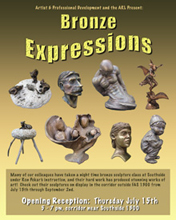This workshop bridges several visual issues simultaneously. The concept of studying and learning about the figure crosses into the use of the figure as a vehicle in an exploratory manner; that is, using color expressively in a dynamic presentation condition.
The process of drawing the figure starts by using black on white (or a dark color on a light background) and exploring the value scale; and then, the process crosses into the use of color to further explore forms in an explosive manner using, for example, intuitive discord, warm and cool colors, colored lines and random movements, as well as, dark and light colored tones.
The standard of observation and examination of local color (i.e., flesh tones, the appearance of clothing colors, linear edges, background colors, application textures and their combinations) will be crossed as participants use colors that are "pushed" into more expressive and dynamic uses.
This workshop presents ways to interject more color than is actually there. It presents the "how to's" of using additional color to express particular special effects and/or moods. It incorporates historical aspects of color projection in visual presentation. It uses an understanding of the simple "color wheel" for personalized color exploration among artists ranging from those developing traditional media to computer generated images.
This workshop bridges several visual issues simultaneously. The concept of studying and learning about the figure crosses into the use of the figure as a vehicle in an exploratory manner; that is, using color expressively in a dynamic presentation condition.
As in all of my workshops, sessions can be tailored, formulated and formatted to meet specific time and availability schedules, however, a 6 week, 2 hour per session (or 12 hours divided by mutual convenience) would be "about right" for participants.
Note: This is a new series of classes that has, recently, been well received.

 Categories of Work
Categories of Work

